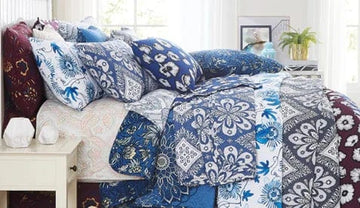Technology and Sleep: Seven Tips for Creating a Technology-Free Bedroom for Better Rest

According to the Centers for Disease Control and Prevention (CDC), in 2020, as many as 14.5% of Americans struggled to fall asleep and stay asleep. While sleep disorders and other medical issues could be the culprit, there is always a possibility that you’re simply spending too much time consumed by technology.
Disclaimer: If you continue struggling to sleep, contact your doctor to discuss your symptoms.
Revamp your bedroom by shopping for a luxury duvet cover today!
Technology and Sleep: How Does Using Technology Affect Sleep?
According to Dr. Micheal Breus’ article, sleep and technology should generally be separate activities. Dr. Breus says that sleep deprivation and technology are often linked, which can potentially lead to an increased risk of sleep disorders and other health problems.
Technology disrupts sleep in the following ways:
- Confuses your circadian rhythm: Studies suggest that the blue light produced by screens reduces the amount of melatonin (the sleep hormone) produced in the brain. This makes it more difficult for the brain to realize it’s time to fall asleep and makes it more difficult to stay asleep.
- Distracts your brain from relaxation: The content can also be problematic as it can be overly engaging right before bed.
- Negatively affects sleep duration: Many forms of technology create a time-consuming environment that we can get caught up in, leading to wasting hours we should be sleeping.
Bonus tip: Be mindful of the brightness of LED lights that emit blue light in your home (especially your bedroom), as these can also affect melatonin production.
What Is the Right Balance Between Technology and Sleep?
According to Dr. Breus, everyone should strive to get screens out of the bedroom and avoid screens altogether for 30-60 minutes before bed. He notes how this is true for everyone but warns that technology is especially harmful to children’s sleep cycles.
If you’re struggling with getting comfortable in bed, try deep pocket sheets to avoid that annoying loose-fitted sheet. For colder months, pair this with a cozy comforter to stay extra comfortable.
Tips on How To Create a Technology-Free Bedroom
Creating healthy sleeping patterns by avoiding electronics in your bedroom may be the ideal way to get quality sleep.
Consider the following steps to create a technology-free bedroom:
-
Make a Detailed List of All Your Electronics
Make a list of all your electronics (specifically those that emit light), how you use them, and how long they need to charge. This can be beneficial in figuring out a solution for reducing or eliminating nighttime usage.
-
Dedicate a Space Outside the Bedroom To Charge and Store Electronics
Storing and charging electronics outside your bedroom can help you avoid the temptation to use them during your nighttime routine. If you’re uncomfortable storing your electronics in a communal space, consider at least storing and charging your devices away from your bed face down to avoid temptation and exposure to the blue light.
-
Commit to a “Screens Off” Time
Setting a time every day to turn your screens off (or at least silence notifications) can make or break a good night’s rest.
-
Set Boundaries With Your Peers
Let those you engage with regularly, such as family, friends, colleagues, etc., know you will be unplugged by a specific time each night.
-
Make Switches
Switching out electronics you used as part of your nighttime routine can make the transition easier such as:
- Get a white noise machine instead of listening to calming sounds on your phone.
- Get an old-fashioned alarm clock to replace your phone alarm.
- Keep a book or magazine by your bed to replace watching TV.
-
Get into a Bedtime Routine
According to the Sleep Foundation, everyone needs a bedtime routine to signal the brain to know when it’s time to sleep. Whether it’s a bath, journaling, listening to music, reading, or some light yoga or meditation, find something that helps you relax and do it at the same time every night. And don’t forget to brush your teeth, of course.
-
Consider a Sleep Tracker
While it might seem counterintuitive since most sleep trackers connect to your phone, using a sleep tracking app can help you better understand what is and isn’t working when finding a nighttime bedtime routine.
If You Can’t Go Without, Try This
A strict no-technology policy may not be plausible for everyone. If you’re finding it difficult, try to at least cut back on how many electronics are in the bedroom. You could also start with easier steps such as:
- See if your phone has a night mode. According to Dr. Breus’ article, studies suggest that using “nighttime mode” and reducing the brightness on devices may assist with better melatonin production.
- Put devices in a drawer or cabinet while you sleep.
- Commit to not using electronics at least an hour before you want to be asleep.
While winding down with some late-night television has become a pretty common American pastime, sleep and technology aren’t very compatible. By striving to make your bedroom a technology-free environment, you may be able to improve your sleep.
Update your bed topper with a high-quality, ultra-soft quilt today!
Sources:
Breus, M. (2024). Technology and Sleep.
Pacheco, D. (2023). Bedtime Routines for Adults.
Sleep Difficulties in Adults: United States, 2020. (2022).



